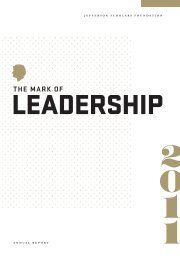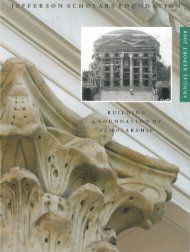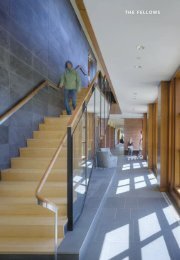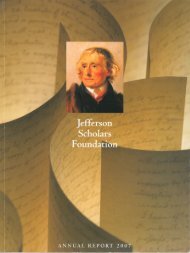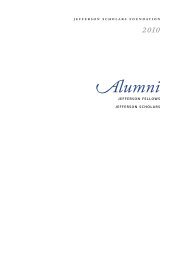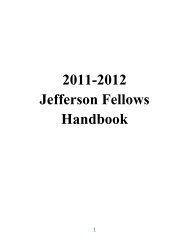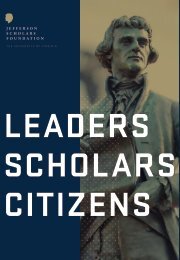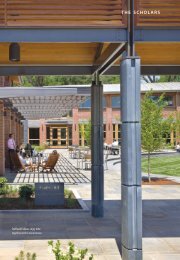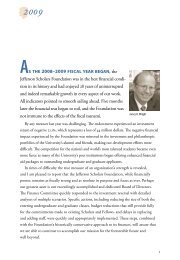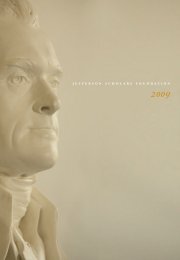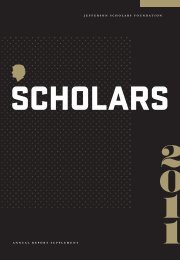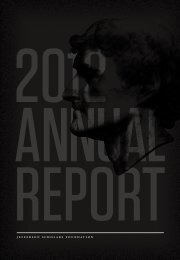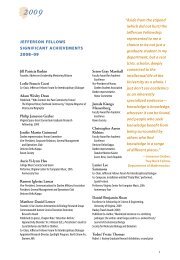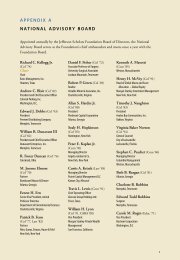2010 - Jefferson Scholars Foundation
2010 - Jefferson Scholars Foundation
2010 - Jefferson Scholars Foundation
You also want an ePaper? Increase the reach of your titles
YUMPU automatically turns print PDFs into web optimized ePapers that Google loves.
jefferson scholars foundation <strong>2010</strong><br />
York City poetic avant-garde and<br />
a fixture in the Arensberg Circle,<br />
in Loy’s largely autobiographical<br />
long-poem “Anglo-Mongrels<br />
and the Rose” (1923-1925). In<br />
particular, these new analyses<br />
cast Fountain as a study in liminality<br />
due to the piece’s ability to<br />
reveal the murky interstices that<br />
lurk at the edges of distinct artistic,<br />
cultural, and social spheres.<br />
Taking up Fountain’s torch, in<br />
“Anglo-Mongrels and the Rose,”<br />
Loy also uses human excreta in<br />
order to champion a mongrelized<br />
voice constituted of physical,<br />
material, and ideological defecathe<br />
eighth annual jefferson fellows symposium<br />
Held Friday, February 19, <strong>2010</strong>, at the Rotunda and in various Pavilions across the Lawn, the<br />
symposium featured ten presentations from current <strong>Jefferson</strong> Fellows. The symposium’s methodology<br />
is simple: provide an opportunity for <strong>Jefferson</strong> Fellows to engage with members of the University<br />
community to discuss aspects of their current research. The preparation, and then the presentation<br />
itself, allows the Fellows to hone their research and teaching skills and gain valuable feedback.<br />
william<br />
dirienzo<br />
Stellar Nurseries: Recent<br />
progress and problems in<br />
Star Formation Research<br />
Stars are the most fundamental<br />
astronomical objects. They were<br />
the focus of astronomy long<br />
before humans had any detailed<br />
information about their nature.<br />
One of the first questions we<br />
often ask about a novel object<br />
or phenomenon is “Where<br />
did it come from?” Indeed, astronomers<br />
ponder the origin<br />
of anything they see through<br />
a telescope; however, despite<br />
all our years of observational<br />
and theoretical work, many of<br />
the fine but important aspects<br />
of star formation are not fully<br />
understood. In particular, the<br />
mechanism by which massive<br />
stars form is difficult to describe<br />
in detail. I will begin with a<br />
review of our current body of<br />
knowledge along with what<br />
we think we know about star<br />
formation. Then I will proceed<br />
to outline the unresolved issues<br />
and current research designed to<br />
address these points, including<br />
my own search for examples of<br />
triggered star formation within<br />
the Milky Way.<br />
upon Marcel Duchamp’s contemporaries<br />
and the generations<br />
that followed, attempts to situate<br />
this scatological readymade<br />
within the context of the literary<br />
arts have left scholars responding<br />
largely as they claim poets<br />
did when confronted with the<br />
piece: scratching their heads. Yet<br />
recent scholarship that recuperates<br />
Fountain’s homoerotic and<br />
racial overtones by focusing upon<br />
contemporary fears of queer<br />
activity in public toilets suggests<br />
the debate Fountain sparked<br />
proved pivotal for Mina Loy, a<br />
prominent member of the New<br />
laura<br />
goldblatt<br />
An Abjective Art: The<br />
Interstitial Aesthetic<br />
of marcel Duchamp’s<br />
“Fountain” and mina Loy’s<br />
“Anglo-mongrels and the<br />
Rose”<br />
Despite prolific critical examinations<br />
of Fountain’s influence<br />
Laura Goldblatt, the John F. Lillard Fellow (English), discusses the Language of<br />
Cultural Abjection.<br />
114



